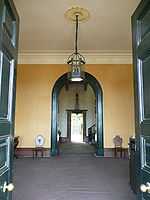Elizabeth Bay House
/E/(1)ElizabethBayHouse4.jpg)


Elizabeth Bay House is a historic home in the suburb of Elizabeth Bay in Sydney, New South Wales, Australia. Built between 1835 and 1839, Elizabeth Bay House was known as 'the finest house in the colony'. Elizabeth Bay House is a home in the Regency style, originally surrounded by a 54-acre (22 ha) garden, but now situated within a densely populated inner city suburb. It is managed by the Historic Houses Trust of New South Wales as a museum that is open to the public.
Elizabeth Bay House is a superb example of Australian colonial architecture, best known for its central elliptical saloon with domed lantern and geometric staircase.
History
Elizabeth Bay House was built for Colonial Secretary Alexander Macleay (1767-1848) between 1835 and 1839 on land granted in 1826 by Governor Ralph Darling. The designer of the house is uncertain, with recent research suggesting that the accomplished colonial architect John Verge (1788–1861) was the main designer, but that he was presented with an imported scheme that he modified for Macleay. The fine detailing demonstrates the role of Verge's partner John Bibb. The house's facade is severe, owing to its incomplete nature: like many colonial houses begun in the late 1830s, the house is unfinished, the victim of Macleay's growing financial distress and the severe economic depression of the 1840s. It was originally intended to have an encircling single-storey Doric colonnade (included in several views by Conrad Martens, and akin to the colonnade at Vineyard, designed by Verge for Hannibal Hawkins Macarthur); the small portico was only added in the early 20th century.
The main axis of the house is aligned with the winter solstice. Though no documents are known to discuss this feature, it is not likely to be an accident.
A rear service wing (since demolished) contained a kitchen, laundry and servants' accommodation, and a large stables (also demolished) was sited elsewhere on the estate. A design for a proposed bathing pavilion imitated the Tower of the Winds in Athens. The pavilion was intended for the extremity of nearby Macleay Point, facing Rushcutters Bay and which was poetically named Cape Sunium after the peninsula east of Athens with its picturesque ruined temple.
The house has been refurnished in the style of 1839–1845, the interiors reflecting the lifestyle of the Macleays and presenting an evocative picture of early 19th century Sydney life. Largely in the Greek Revival style with elements of the Louis revival, the house's interiors have been recreated based on several inventories, notably an 1845 record of the house's contents and a list of furniture sold to the newly completed Government House, plus pieces known to have originated at the house that is now located at Camden Park or Brownlow Hill (originally the Macleays' country property near Camden, NSW). The large library contains several insect cases and a desk originally owned by Macleay, on loan from the Macleay Museum at Sydney University. Wall colours have been determined from paint scrapes that revealed the original colour schemes. The house also contains a collection of significant early Australian furniture from Sydney and Tasmania.
A nearby grotto, with accompanying stone walls and steps, plus several trees, are all that remain of the original extensive garden, which contained Macleay's considerable native and exotic plant collection, an orchard and kitchen garden. A hand-written notebook of "Plants received at Elizabeth Bay" in the collection of the Mitchell Library (State Library of NSW), is indicative of the original collection.
References
- Broadbent, J. The Australian colonial house : architecture and society in New South Wales 1788-1842. Sydney, Hordern House in Assoc. with the Historic Houses Trust of NSW. 1997
- The Book of Sydney Suburbs, Compiled by Frances Pollen, Angus & Robertson Publishers, 1990, Published in Australia ISBN 0-207-14495-8
| Wikimedia Commons has media related to Elizabeth Bay House. |
External links
Coordinates: 33°52′12″S 151°13′35″E / 33.8701°S 151.2264°E